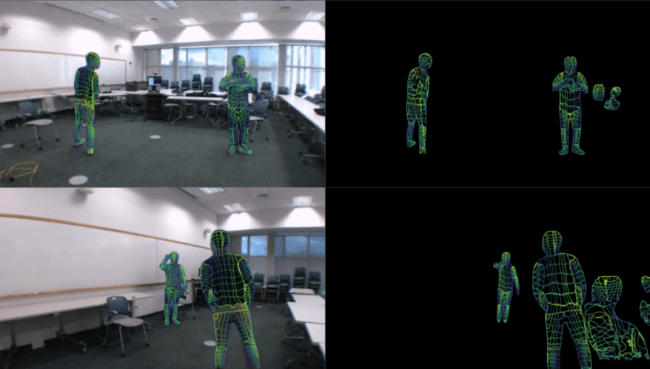Wi-Fi Pose Detection: Researchers Show How the Media Got it Wrong
Insights | 26-01-2023 | By Robin Mitchell
Recently, researchers demonstrated how Wi-Fi and advanced imaging technology, using scientific and engineering principles, can detect people in a room and determine their pose, but media reports, despite facts and logic, falsely claim it can "see through walls," raising concerns about privacy and challenging the notion of truth and accuracy in reporting. What challenges do camera systems face, what did the researchers demonstrate, and why do the media always get these reports wrong?
What challenges do camera systems face?
There is no doubt that the advantages that digital camera technologies provide are vast. The ability to turn images into digital signals that can then be stored, recalled, and manipulated helps power numerous applications, including advanced vision systems in self-driving vehicles, security monitoring systems protecting areas of interest, and empowering individuals with the ability to record events that can prove to be pivotal in a legal case. Of course, there are also the more obvious uses for digital cameras, including social media (via selfies) and TV, which demonstrates that digital camera technologies do indeed touch most industries, both engineering and creative.
But for all the benefits cameras provide, they also introduce several challenges, and most of them surround privacy. Simply put, the increased integration of camera technologies into everyday devices in combination with internet connectivity leaves any internet-connected device vulnerable to cyberattack, thus exposing the integrated camera to the attacker. This is problematic as cameras do not announce their operation with a light, sound, or vibration, meaning it is impossible to tell if a camera is currently recording. Of course, it is possible to integrate LEDs that turn on when data is being read, but this is often impractical from an engineering perspective, and it is also possible for attackers to find methods around these to secrete record.
Images and videos obtained by criminals can be used in multiple different ways. One such way would be to spy on individuals in a property and identify times when that property is empty (thereby providing the perfect opportunity to burgle). Another use is to obtain indecent images of victims for the purpose of blackmail. Images obtained from cameras can even be used for tracking if key landmarks can be identified in the background.
Researchers develop Wi-Fi pose detection
One useful application for digital cameras is pose detection in humans, as this not only enables for identifying individuals but also identifying their state (whether they are resting, standing, agitated, or aggressive). Combined with AI, such cameras could then be used to identify escalating situations that then alert security personnel. This same technology could also be used inside homes to monitor the safety of individuals, especially those who are vulnerable (such as the elderly).
However, the high resolution of cameras means they can also see in great detail, which introduces the many privacy challenges we previously mentioned. This is one of the reasons why many homeowners are uncomfortable with installing cameras.
Recognising the challenges with privacy, researchers from Carnegie Mellon University, in conjunction with the University of Waterloo, have developed a new technique for pose detection that uses only Wi-Fi Signals. By combining Wi-Fi transceivers with AI, the researchers were able to create a model that can detect the presence of people in a room and determine what pose they are doing (such as standing, sitting, and lying down).
The technology works similarly to RADAR in that Wi-Fi signals emitted from a transmitter bounce off distant objects, and these reflections are recorded. However, as Wi-Fi signals can take multiple different paths, the recorded data requires a large amount of noise discrimination and processing. Furthermore, the researchers only look at changes in the reflected signal so that static objects which produce the same reflections are ignored.
One of the major advantages of using Wi-Fi is that it can penetrate numerous objects and diffract around walls. This means that those standing behind furniture or lying on the ground can be detected, while traditional imaging systems would otherwise fail to detect those occluded by objects.

Why does the media always report misinformation?
What the researchers have demonstrated here is a true feat of brilliance; the combination of only Wi-Fi signals with AI to identify people in a room without violating individual privacy while being able to see past objects. However, just as most news is sensationalised, this announcement from the researchers has been picked up by multiple media outlets and spun with a headline that doesn’t truly reflect the research.
One common headline is “researchers see through walls with Wi-Fi”, despite the original paper never mentioning the ability to see through walls. Other reports have noted how the Wi-Fi transmitter is positioned behind a wall, yet the original paper doesn’t describe this in the experimental setup. It is likely that either the researchers misspoke about their capabilities, or more likely, reporters have scanned through the paper and seen the term “occlusion”.
Unfortunately, this is all far too common in the media industry, where reporters either fail to check their source material or just regurgitate what they have read elsewhere (which seems to be the case here). Thus, the media reports incorrect facts about some research by extrapolating and exaggerating what it means and misinforming the public about what is really being done. Why do they do this? Most likely to garner clicks and drive traffic, but in the field of science, this is something that shouldn’t matter, as facts are essential for finding the truth, and progress can only be made on truths.

